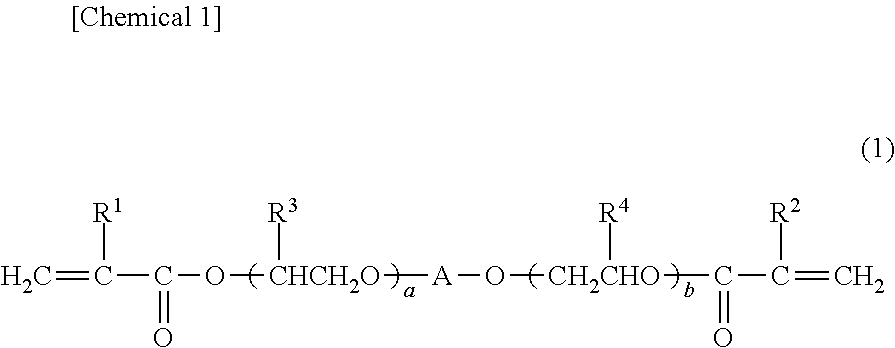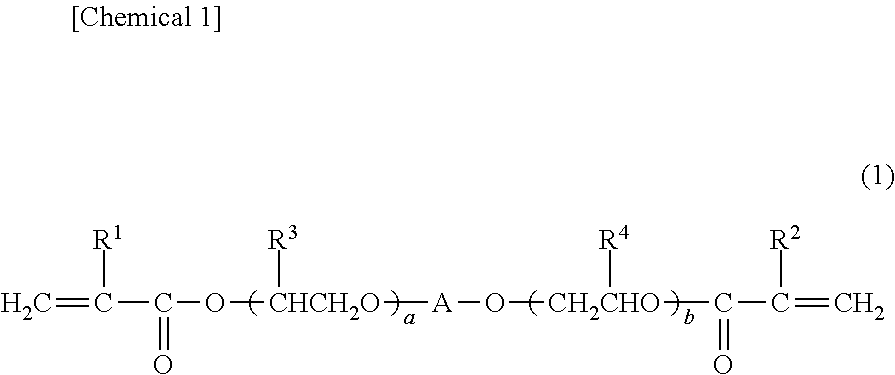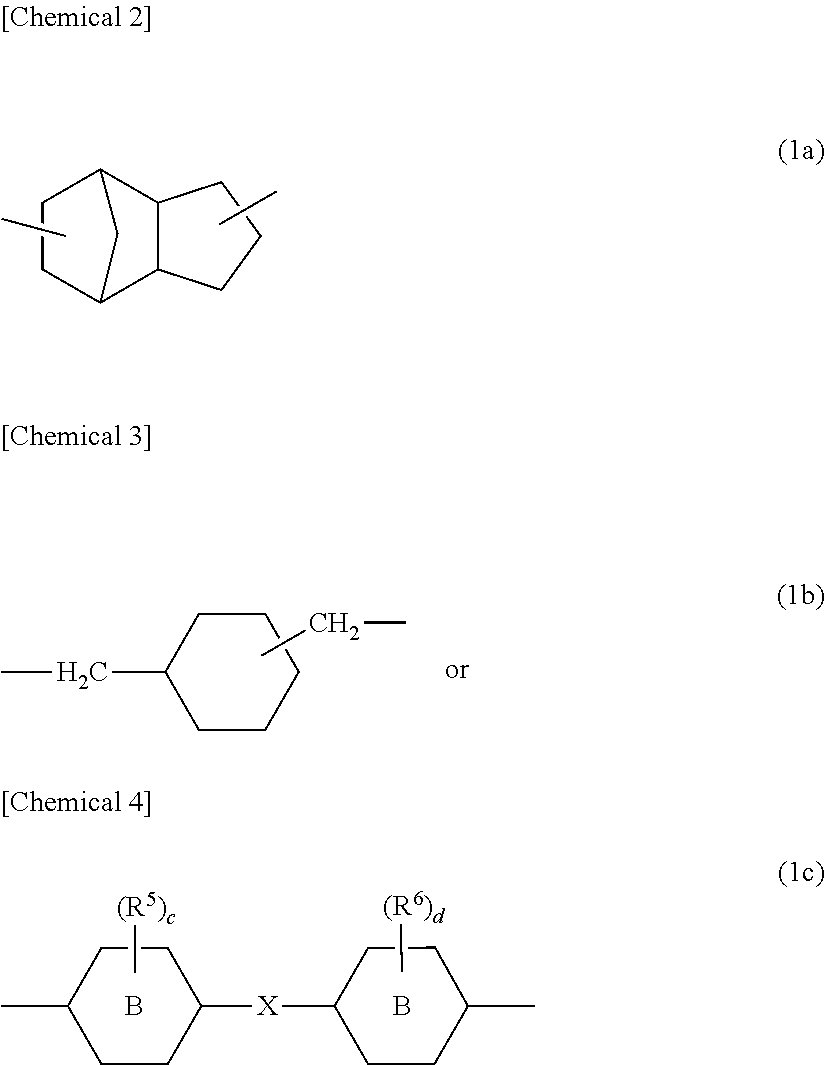Photochromic curable composition
a curable composition and photochromic technology, applied in the field of photochromic curable compositions, can solve the problems of low scratch resistance of photochromic coatings formed by using the above photochromic coating agents (a) to (d), easy scratching of photochromic coatings, and decreased scratch resistan
- Summary
- Abstract
- Description
- Claims
- Application Information
AI Technical Summary
Benefits of technology
Problems solved by technology
Method used
Image
Examples
example 1
[0513]The radically polymerizable component (A) was prepared by mixing the following components together.
AC-SQ TA-100 (silsesquioxane component (A1))5parts by massBPE 500 (bifunctional radically polymerizable100parts by massmonomer (A2))
[0514]To 100 parts by mass of the thus prepared radically polymerizable component (A), there were added:
PC1 (photochromic compound (B)) 2 parts by mass,TINUVIN 765 (light stabilizer) 5 parts by mass,IRGANOX 245 (antioxidant) 3 parts by mass,CGI 1800 (polymerization initiator)0.5 parts by mass,
which were mixed together to a sufficient degree to obtain a photochromic curable composition (coating agent) for use as a coating agent.
[0515]Next, as the optical material, there was provided a thiourethane resin plastic lens (MR) having a thickness of 2 mm and a refractive index of 1.60.
[0516]By using a spin coater (1H-DX2, manufactured by MIKASA Co.), the above moisture-curable primer was applied onto the surface of the plastic lens (MR) at a revolving spe...
examples 2 to 77
[0520]Photochromic curable compositions (coating agents) were prepared by conducting the same operation as that of Example 1 but preparing the radically polymerizable component (A) by using the silsesquioxane components (A1) having radically polymerizable groups, bifunctional radically polymerizable monomers (A2) and other polymerizable monomers (A3) shown in Tables 1 to 5 and, further, using the photochromic compounds (B) shown in Tables 1 to 5. Photochromic lenses were obtained therefrom relying on the coating method.
[0521]The obtained lenses and the prepared photochromic curable compositions (coating agents) were evaluated in the same manner as in Example 1 to obtain the results as shown in Tables 6 and 7.
TABLE 1(A) Radically polymerizable components(mass parts)Ex.ComponentComponentComponentNo.(A1)(A2)(A3)*1AC-SQ TA-100BPE500—PC1 (5)(100)(2)2AC-SQ TA-100BPE500—PC1 (10)(100)(2)3AC-SQ TA-100BPE500—PC1 (25)(100)(2)4AC-SQ TA-100BPE500—PC1 (50)(100)(2)5AC-SQ TA-100BPE500—PC1(100)(100)...
example 78
[0526]The radically polymerizable component (A) was prepared by mixing the following components together:
Silsesquioxane component (A1);[0527]PMS1: 20 parts by mass
Bifunctional radically polymerizable monomer (A2);[0528]Long-chain bifunctional radically polymerizable monomer (A2′).[0529]BPE 500: 10 parts by mass[0530]Short-chain bifunctional radically polymerizable monomer (A2″).[0531]BPE 100: 60 parts by mass[0532]4G: 30 parts by mass
[0533]Other radically polymerizable monomers;[0534]GMA: 1 part by mass[0535]αMS: 8 parts by mass[0536]MSD: 1 part by mass
[0537]To 100 parts by mass of the thus prepared radically polymerizable component (A), there were added:
PC1 (photochromic compound(B))0.04parts by mass,TINUVIN 765 (light stabilizer)0.1parts by mass,Perbutyl ND (polymerization initiator)1part by mass
[0538]Perocta O (polymerization initiator) 0.1 part by mass, which were mixed together to a sufficient degree to obtain a photochromic curable composition for use as a material for forming...
PUM
| Property | Measurement | Unit |
|---|---|---|
| volumetric shrinkage | aaaaa | aaaaa |
| volumetric shrinkage | aaaaa | aaaaa |
| temperature | aaaaa | aaaaa |
Abstract
Description
Claims
Application Information
 Login to View More
Login to View More - R&D
- Intellectual Property
- Life Sciences
- Materials
- Tech Scout
- Unparalleled Data Quality
- Higher Quality Content
- 60% Fewer Hallucinations
Browse by: Latest US Patents, China's latest patents, Technical Efficacy Thesaurus, Application Domain, Technology Topic, Popular Technical Reports.
© 2025 PatSnap. All rights reserved.Legal|Privacy policy|Modern Slavery Act Transparency Statement|Sitemap|About US| Contact US: help@patsnap.com



